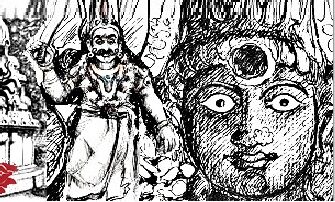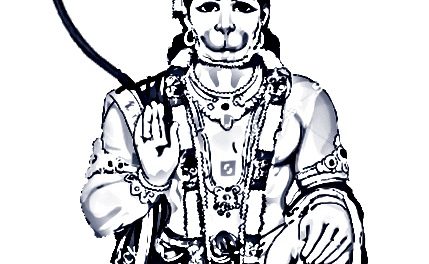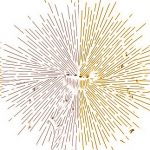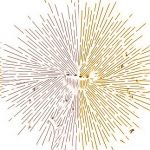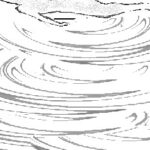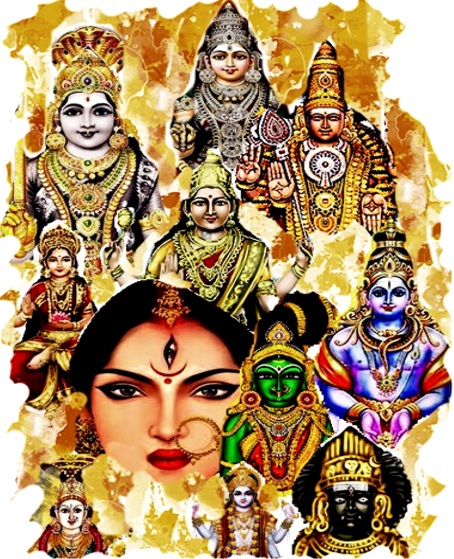 KULA DEVATHA OR TUTELARY/FAMILY DEITIES:
KULA DEVATHA OR TUTELARY/FAMILY DEITIES:
ORIGIN AND CONCEPT – 2
-Santhipriya-
101. Once created, the seven hermits stood before Brahma confused, as they did not know why they were created. Brahma informed them that they were created to act as his prime messengers when the universe gets activated. He explained to them all aspects of four Yugas, characteristics of souls in each Yugas, birth-death-rebirth circles for each of the souls, male-female theory, their partnership, children, ethics, norms in life, good and bad deeds, sins, their worship pattern, the manifestation of several divine forces in different appearances and shapes in different periods of time in different parts of the land. He further explained the importance of Kula Devatha or Tutelary/Family deity and how the souls will remain under the control of the divines, Kula Devatha or Tutelary/Family deity who would guide and guard them in the lands they manifest and many more such details and directed that they wait in invisible and inactive form for the present till they get activated by him.
102. They were clearly told that as and when Brahma activated the hermits at appropriate time, they will have to begin educating humans on need of divines and paths of divinity so that the divine messengers in human form could also carry forward the preaching and teaching initiated to them thus articulating the Guru-Shishya relationship.
103. At the end of the doctrine by Brahma, the invisible Maharishis waiting for an opportune time to appear before public, got married with certain female souls created for them and entered in the land to accomplish their task. All of them remained inactive and invisible studying the aspects of the universe in silence.
104. It took several thousands of years for the Maharishis to understand the entire philosophy of the Universe and the doctrines of Brahma as the subject matter was vast, minute and complicated.
105. The next act of Brahma was creation of souls to be sent to the universe. All the souls released by him did not instantly take birth as humans. The souls initially released by Brahma turned into 15 to 20 categories of species from whom some percentage of the species turned into humans millions of years later in the course of four to five stages of evolution. Why was the said situation created and why not humans directly created?
106. From the findings of the scientists of Archaeological and Anthropologists, it is clear that the initial creations of Lord Brahma might have been in the category of Anthropoidea (the bigger-brained monkeys and apes) and 15 to 20 categories including dinosaurs, and chimpanzees like figures, mammals, trees and plants of nature. The movables lived by the side of mountains and rivers in plain land or thick forested areas created by Lord Brahma.
107. The scientists who studied the aspects of the Universe (Anthropologists) opine that some form of humans appeared only few million years ago from the present Yuga. Though the first primitive primates in the category of Anthropoidea (the bigger-brained monkeys and apes, including humans) appeared 55 million years ago, our oldest human ancestor thought to have walked on two legs evolved only about 6 million years ago due to the biological changes that caused the tailless apes and chimpanzees turn into the form of humans walking with two legs without knowledge.
108. As mentioned earlier, after Parabrahman released the cosmic it may have taken 13.699 billion years for the earth’s natural environment to get transformed to become a place where diverse life forms, including humans, can thrive. We can therefore believe that no divines including Kula Devatha or Tutelary/Family deities appeared for over 13.699 years after the cosmic was created .
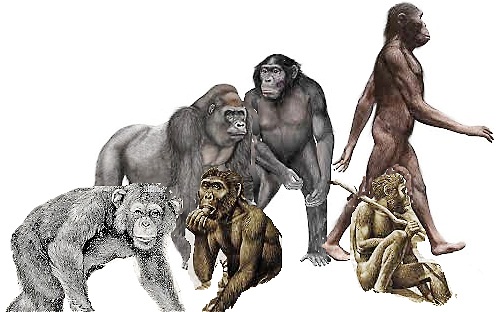
109. Brahma needed time for the living creatures to slowly settle down on earth, get accustomed to the environment before a percentage of them get turned into humans. It again took thousands of years for those to gain knowledge and to understand what was around them and get accustomed with natural inhabitant places like mountains, caves, rivers, lakes etc.
110. Initially Brahma released from his body four broad based group of souls with certain aspects. Several thousand years later those four broad based souls took the form of humans and further got divided into several groups or castes with endless branches after they gained sufficient knowledge. Only those four broad based groups of souls with certain aspects initially released by Brahma became four categories in human race.
111. He meticulously worked out specific time frame, Yuga specific characteristics to the souls who will live on the land and gain sufficient knowledge to distinguish each from the others. Brahma decided that the entire souls created in the first Yuga will not instantly get converted into humans, but part of the souls will remain floating on the plane awaiting their conversion into some form, in the land in Satya Yuga itself or will still be floating without getting any form till end of Satya Yuga. This concept of floating souls was to display to the universe, the male-female theory- both human and animals- whose inter union cause birth of a child- human or animal- by converting some of the floating souls on the plane into their child. This is how the floating souls got converted into human or animals in some form and fulfill the requirement of the Yuga specific population pre fixed.
112. The view that our oldest human ancestors, thought to have walked on two legs, appeared only 6 million years ago and that some divines too appeared on the vast land only during such period, tally with that of Rigvedic period. This thus support the view that the worship of deities may have also began during the said vedic period.
113. The narratives based on the vedic texts and history halts here and story on the emergence of divines as narrated by word-of-mouth stories, discourses, as heard form temple priests and folk tales follows as given below.
114. After creating the vast land, Brahma divided the space into several pieces to facilitate the souls to go and settle in the spaces of their choice. He deliberately left the choice to the discretion of the human souls where to settle down. The clear picture on the demographic structure or terrestrial area of space created is not known, but pundits opine that they included entire universe covering mountains, rivers beside forested areas covered with thick trees and animals.
115. The body of those souls which settled in spaces which were imbibed with divine in nature automatically absorbed the good qualities and spiritual in nature embedded in those spaces.
116. Similarly whichever souls entered other spaces imbibed with other qualities, their bodies too automatically absorbed those qualities. This was kept as basic norms in canon of creation, lest one would not be able to realize the impact of good and evil or after effects.
117. The spaces imbibed with divine in nature were mostly occupied by the souls of saints, rishis and other spiritual minded folks while the rest of the spaces were occupied by other souls.
118. After the humans were activated, the seven Maharishis created by Brahma got activated and came out in open in those places where the souls turned into hermits entrenched. The seven Maharishis spent several days giving sermon to several divinely soled humans and turned them into the forms of Rishis, Sages, saints who carried forward the messages of creation to the humans which appeared on the vast land during Satya Yuga which was the first Yuga released by Brahma.
119. Several thousand years passed, the task force consisting of Rishis, saints and sages created by the seven Maharishis moved all around where humans had settled and began to give spiritual doctrines and knowledge to the mankind the on the divine acts & plays.
120. Now this was the period when the divines started appearing on the vast land. They were sent by the first line of divines. While the first line of divines continued to stay invisible in the sacred land created in the vast space (above earth), they sent the second line of divines to the vast land to appear and enact divine plays.
121. How to get the folks fall into the spiritual world of divinity? The first act was infusion of fear in the minds of humans by unknown terrifying sounds and flash of eye breaking lights stating that those were due to the anger of the invisible divines; it was followed by preaching of ethics and norms to be practiced in one’s life stating that practicing them will only tone down the anger of those invisible divines . Infusion of fear was necessary to force them to accept the theory of invisible divines who were to appear to guide and guard them as Kula Devatha or Tutelary/Family deity at much later stages.
122. While Brahma was developing the universe from primitive stage to that of human habitats, there in Supreme Loga the appearances of divines were getting shaped.
123. Deleted
124. Though it is unclear as to how the divines whom we see today received specific appearances and shapes, the broader opinion is that they received their features and appearances inside the body of Parabrahman.
125. However, the matter for debate is how the prime divines like Siva, Maha Vishnu, Brahma and Parvathi were shaped inside Supreme. Were entire fleet of divines who were created and energized inside the Supreme sent to earth? Were features of each divine pre-determined? These are some of the most difficult queries that remain unanswered.
126. Some of the spiritual masters explain that even before the Cosmic was created several lakhs of invisible divines and deva ganas existed as divine energy rays within Supreme with certain characteristics and appearances. Supreme plane was centralized energy center called Loga of Supreme in which lakhs of divine energy rays remained stored. Remember that the earth and ocean were also lying inactive inside Supreme till he released them.
127. In the opinion of several pundits, prior to converting his energy rays in different forms and appearances, a principal architect of the universe Vishvakarma –Deva Shilpi- was created by Supreme to shape the appearances of divines within him (Supreme) in the form of divine energies. It is believed that the divine architect sitting inside the body of Supreme gave shape and appearances to the entire fleet of divines that included prime divines like Siva, Vishnu, Brahma and Parvathi.
128. The Rig Veda mentions about the role of Deva Shilpi Visvakarma and so are few more Upanishads. Accordingly, Deva Shilpi Visvakarma brought out several images from his nave and used them as models for shaping the divine appearances. In the historical vedic religion, the role of Visvakarma as the builder of gods is attributed to Tvastar who was vedic artisan god or fashioner. Vedic Visvakarma is identified with Prajapati rather than Tvastar.
129. In later mythology, Visvakarma is sometimes seen identified with Tvastar who is a craftsman deity. Some of the vedic literature indicate that Prajapati and Tvastar were associated with creation, though in different ways. Prajapati is indicated as ‘lord of creatures’ while Tvastar is shown as a skilled craftsman who fashioned and created implements and objects, including weapons and vehicles. From puranas and vedic literature one thing remains clear- one or two craftsmen were responsible for shaping the appearances of divines and other materials needed for the vast land.
130. The divines thus created remained invisible inside Supreme, waiting for call to manifest. Once every form and appearances were finalized inside his body, the invisible cosmic was made visible and it was left to Brahma to chalk out the destination for the manifestation of the divines created, and Brahma was exclusively authorized to work out their time of appearance in the vast land liasoning with first line of divines.
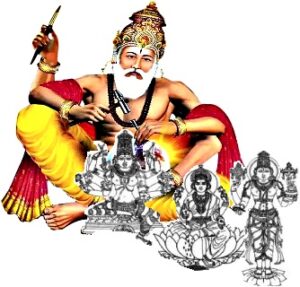
131. This secret was revealed by Brahma to the first sets of Maharishis. Sriman Narayana (Lord Vishnu) too revealed the said secret to Narada Muni by way of sermon called Rahasya Sthuthi. Few pundits also say that the secret was revealed to Parvathi by none other than Shiva himself when they were sitting alone in a cave in Himalayas. Their conversation was overheard by a divine bird which revealed the secrets to hermits and Rishis who transmitted the contents to the folks of the universe by word-of-mouth stories/folk tales.
132. Why were the divines shaped inside the body of Supreme? It is believed that the divine rays which were converted into some forms were needed to be energized suitably to play their active role in the cosmic. Unless the power rays were given some form and energized, it would not be possible for them to absorb or retain the scripts of their role in their body to display them whenever they descended on earth, lest there could be chaos in interaction between divines and humans. Primarily for this reason, divine power rays were given some body shape and appearance to absorb and retain the scripts to practice and rehearse them in the invisible universe inside Supreme.
133. It is interesting to know that during the first half period after the cosmic had been created, invisible energisation process was taking place inside Supreme. During learning process inside Supreme some of the deva ganas and divines incurred curses for one reason or the other for their flaws; similarly, some of the prime deities too accrued certain curses.
134. After the land space was created, when the souls were sent to the universe, many of those divine forces in the form of divine energies too descended on the land and hid themselves in the spaces allotted to them in their own appearance as shaped by Deva Shilpi.
135. Though Sanathana Dharma believe that the features of the divines were known to the mankind only through Maharishi Ved Vyas who is credited to have included the illustrations of Hindu gods and goddesses in the texts compiled by him, but what contradicts the statement is that in those periods of time everything were only transmitted orally and reportedly written on palm leaves later. Perhaps those who compiled them in palm leaves, what Ved Vyasa orally told everyone might have understood the true features of the divines by constantly contemplating (meditating) on them and left the illustrations in palm leaves for future generation to copy them. When the divines emerged in the universe they were given a human sketch by few divine artists like famed Indian painter Raja Ravi Varma (1848-1906), who gave classical representations of Hindu gods and goddesses by understanding the divine features mentioned in the palm leaves or in the oral transmissions.
136. Now coming back to the story, after the land was made ready by Brahma with human inhabitants, he had to also position various other creatures, animals etc. Simultaneously he had to ensure that the divines released by various divines were to be allowed lands to settle in the spaces allotted to them.
137. Prior to sending the souls to earth, Brahma desired to split the divines into various categories and remain invisible in the spaces earmarked for them even before human souls reached there. The divines were to appear gradually as folks gained knowledge and belief to accept the divines.
138. In short, Brahma’s creations included the several categories of divines to guide and guard the humans on earth.
139. The First line of deities were Prime divines in some form and settled in worship places or temples. They were mirror images of Shiva-Sakthi, but appeared in different other form with dual role to play. They enjoyed enormous divine powers to bestow or grant favors to the prayers of those who worshipped them regularly and in sincerity. They could enter any space on earth or air space, land or sea to protect the folks who pray to them sincerely. Besides, they also protected the sub divines working under them whenever their existence was threatened. They were also empowered to manifest in any form whenever and wherever needed to annihilate the evils and war mongering Asura and Draconian forces even if it lay beyond their area of control.
140. The first line of divines possessed unlimited territories to manifest and exercise their divine powers, however without defacing the basic norms of Brahma’s scripts of creation. The first line of divines is in different appearances and names, the classic example being Shiva in the shape of Shiva Ling in many temples addressed in several names. To quote few are Murutheeswarar, Kapaleeswarar, Vaitheeswaran, Chokkanathar and Kumbeswarar etc all of whom appear in the form of a Shiva Ling. Parvathi is represented in the name of Tripurasundari, Lalithambigai, Kamatchi, Karpagambigai, Raja Rajeswari etc. Mahavishnu appears in the forms of Venkatachalapathi, Sarangapani, Srirangam Ranganatha swami, Puri Jagannath etc, etc. Normally all of them do not turn into tutelary deities; only some of them became Kula Devatha/Tutelary/Family deities through their incarnations.
141. Brahma realized that the folks in Satya Yuga called ‘Yuga of truth’ would remain free of greed, free of negativity, free of evilness, pure at heart and acts, free of anger and vengeance etc. Therefore, not much divine forces were needed to guide and guard them in Satya Yuga, but only subsequent Yugas required more divines. Realizing it he ensured that after the cosmic was created, increased number of divines in various forms and appearances were allowed to manifest beginning from Thretha Yuga and continued till the end of the fourth Yuga called Kali Yuga.
142. Brahma foreknew that with the dawn of every new Yuga, the mind culture and behavioral attitude and characteristics of humans would gradually fall from purity to darkness, and by the time the Kali Yuga emerge, the morality of the mankind would have reached the lowest ebb.
143. Brahma was aware that yuga after yugas, the initially created souls would keep multiplying into several million souls even as land space would also increase to accommodate them till end of one Manvantara (306,720,000 human years) . Their behavioral pattern would also vary from Yuga to Yuga as the characteristics of the land would have its influence over their mind culture. Hence Brahma may have planned for the creation of more and more divine forces particularly Kula Devatha or Tutelary/Family deities to take care of the increased populace in each of the Yugas. Perhaps this is the reason why we could see thousands of divine forces of all nature emerging afresh in different parts of the universe from Thretha Yuga itself compared to what has been mentioned in our puranic texts and epics.
144. After the land was made ready for the souls to settle down in the Satya Yuga, Brahma’s creations began to turn into mild knowledgeable creatures. It is believed that the acts like worship of some kind of divine or formless divines began to emerge at a very, very low key and gained momentum somewhere in Thretha Yuga and Dwapara Yuga. As the humans began to gain knowledge, the folks who lived in each patch of land believed that something beyond their imaginations, super humans existed and therefore prayed to the unknown to guard them, which laid the foundation for perfect worship, later expanded to the emergence of Kula Devatha or Tutelary/Family deity worship.
145. The historians and archaeologists confirm that the folks of pre-Vedic period folks began to learn what was known as worship and prayer. Therefore, they worshipped sun, moon, fire, trees, mounts, rocks along with some other unknown forms of nature like rains, thunder and stones fearing that they may harm them if not worshipped. Therefore, one can be sure that the divines with specific form or appearances did not exist during the Rigvedic period and everything began only from Satya Yuga onwards.
146. According to the spiritual masters, Satya Yuga was known as the age of truth, or golden age when humanity was governed by divine, and every manifestation or work was close to the purest ideal and humanity. As per Bhagavata Purana, the morality which was high in the initial yuga stood on four legs which were termed as austerity, cleanliness, compassion and truth.
147. Satya Yuga reportedly began sometime before six to seven million years, when advancement of knowledge began on good scale. It was a time of great beauty, compassion, and understanding and folks began to live in harmony with each other; there was great spiritual awareness too.
148. Repeat- deleted
149. Due to the continuous propagation of sages and saints who were got readied by the seven Maharishis created by Brahma, the feeble belief that someone more powerful than humans existed entered into the mind of folks; slowly the feeling turned into fear for unknown, ultimately leading to some kind of worship to the unknown in open spaces.
150. Since entire land across the universe in the initial stages were patches of land and bushy forested lands occupied by few humans along with animals, the folks worship to stones, rocks and trees which were in vague in Rig vedic period continued to be performed in open spaces for long period of time. The folks feared to go near those specific stones, rocks or even certain trees fearing that something unusual, unknown spirits resided there and therefore stood from a distance and prayed to them to save them.
151. This was happening to the fine-tuned drama of Brahma who wanted the folks to begin accepting the existence of divine forces out of fear. The divines meant to settle in those places entrenched in them in invisible form and kept on increasing the fear of the folks till they completely surrendered to them.
152. The low-lying Maharishis with disciples, Rishis, saints and sages took the opportunity to convert the fear of the folks into some sort of worship pattern by orally transmitting stories to make the folks believe that the mysterious appearances were super humans- called divines – who had come there from space above (heaven) to guide and guard them. Slowly the first set of divines released by the prime divines too began to appear through mystery lightening, thunders, fearful sounds, ghost images etc in several areas and became group specific deities. This is how the group specific deities slowly turned into Tutelary/Family/Kula Devatha in the later stages began.
153. Each part of the land had unknown nos of invisible divine manifest. We need not dwell deeper in to different forms of worship which existed; it will be enough, if one understood that the concept of divine worship began only six million years ago in the vast land.
154. The second line of divines were assigned specific lands which were much bigger areas covered by the third, fourth and fifth line of divines. The Second line of divines were the shadow divines of first line of divines. They were sent to represent the first line of divines. The second line of divines too enjoined enormous divine powers because they were also energy rays of prime divines only but emanated through them. They could exercise their authority and divine powers fully to guide and guard the families under their command.
155. What is the actual difference between first and second line of divines? Not much difference except that the secondary line of divines were mostly manifestations from the first line of divines and rarely released from the body of ‘Supreme’ at the request of Brahma. Though the divine powers vested in them were also the same like the first line of divines, the scope of their authority were restricted to limited areas and for controlling specific groups of divines under them. They were mostly meant to be seated in the shines and temples to bless those who worshipped or prayed to them. They do not normally become Kuladevatha/ family /tutelary deity except in very rare cases. However, they manifested in different forms, or took several incarnations for specific tasks assigned to them. Some of their incarnates however turn into Kula Devatha or tutelary deities much later.
156. The third line of divines were sub divines functioning under second line of divines. They come from sinned or cursed Deva ganas, especially the one who accrued the maximum sin or curse during their stay in ‘Supreme’ Loga, but also include those who assisted the other divines in some war or other events. They also stood as the Guardian deities of the temples of prime divines. They manifested as human or as animals and then turned into Village deities, guardian deities and local deities. Once they became Village Deity, they assisted all other divines who were present in several areas besides guarding the boundaries of space where all of them manifested. Some of the Village deities were also the incarnations of second line of divines.
157. The concept of Kuladevatha/Family/Tutelary deities are in vague only in the southern part of India, while there is no such larger concept in the North. There were several castes and not families which are identified with specific deities whom they worshipped as Ishta devatha or devathas meant for their clan.
158. In north India the concept of Village Deities is mostly unknown except in parts of Bihar, Madhya Pradesh and Orissa where the tribal are concentrated who worship some form of Village Deities. Otherwise in general, Lord Shiva’s Ganas and Snakes, Mohinis, Yogins, Kali, and Lord Bhairava are kept in the village entrances or in the first reachable temples to stand guard to their villages. Some of the statues used to be in half body, some have only the face of some Deity or simple Stone that were worshiped. They believe that the said Deities stand guard to their area. Apart from it they also believe that Lord Anjaneya is the Guardian Deity. May be this belief has been the reason to find several temples with Anjaneya installed in the form of a simple stone painted in orange colour. Those temples used to be the place where Anjaneya resided to guard the Village from attacks of evils.
159. Only from the third line of divines and below, the Kuladevatha/Family /tutelary deities emerged in southern India. Village deities are worshipped by villagers as a part of a long, continuous tradition in rural India. The famous Village deity Kathavarayan is believed to be the incarnate of Muruga who incurred a small curse from Shiva and born as Kathavarayan to atone the sin. Another famous Folk deity called Madurai Veeran, a cursed Devagana from Devaloga is believed to protect city Madurai and Madurai Meenakshi Amman Temple. He is also worshipped by many as their Kula Devatha or Tutelary/Family deity. The other Village deities include Ayyanaar who is reportedly the incarnate of Aiyappa besides Sudalai Madan, Ezhu Kanniyar and Sangali Karuppan etc. The seven virgins and Kanakampikai Amman is the guardian goddess of the Vanni region in Sri Lanka.
160. How do the Devaganas turn into Village/Guardian deities? Those of the Deva Ganas who came down to earth, either born as human or entered into the body of human or animals, displayed heroic acts through them and at the end of the penance period they became folk deities in the name of Village/Guardian deities. Once they became Village/Guardian deities, they were given some responsibilities and limited divine powers. Though the folk deities with those limited powers cannot answer the prayers of devotees for personal benefits, they were noble enough to get the boons bestowed through their master Kula Devatha or Tutelary/Family deity of that area. At the same time, even with those limited powers the Village/Guardian deities were able to prevent the evil spirits and demonic spirits (who carried sins in deva Loga and born to atone their sins) from entering into the village and drive them out from the village.
161. Over a period of time, the folk deities, who were in the fourth line of divines appeared in the dreams of some of the folks and commanded them to accept them as their family god and worship them in a particular manner. The sufferings of those families who offered worship to the folk deity when begin to recede, partly with the discreet support of the folk deity’s master Kula Devatha or Tutelary/Family deities, more families began to consider the folk deity as divines. In this manner the folk deities slowly marched into the bandwagon of tutelary deities.
162. Though the folk deities, fourth line of divines, could effectively prevent the natural disasters causing destruction in the villages, they were unable to destroy all the evil ghosts and evil spirits because few of them were created by Brahma for certain reasons. However, the folk deities were able to drive away the ghosts and evil spirits from their area of control. As the performance of the folk deities begin to increase, more and more powers as enjoined by a Kula Devatha or Tutelary/Family deities were bestowed on them by Brahma to fall into the line of divines.
163. However, the fourth line of divines do not normally become Kuladevatha/Family /Tutelary deities, but remain guardian deities to the entire village which they represented. They assist the Kula Devatha or Tutelary/Family deities in many manners and carry out their command by working under them. Therefore, some group of facilities in the interior villages adapt them as their Kula devatha.
164. The fifth line of divines are blessed ganas who entered into the body of humans or animals and turn into angels or village guardian deities over period of time. Staying inside the body of some one in the village, the devaganas render several good deeds to the villagers. They thus draw the appreciation from the villages and receive respect from the locals.
165. After the demise of those humans or animals from whose body the fifth line of devaganas functioned, they were buried and a memorial pillar or inscription stone will be erected over them thus converting the spot into place of a kind of worship. The souls inside their body of those dead would settle in those sites in invisible manner and continue to protect the village as guardian deity or guardian angel because they carried some aspects of divine powers received from first and secondary line of divines who sent them to become angels in those villages. Several years later some of them turn into Kula Devathas of poor villagers in those areas, and never migrate to any other areas.
166. The next most important question that arises is how does the Kula Devatha or Tutelary/Family deities get identified by the families ? The deities of all varieties manifest in the lands allotted to them and then reveal their presence through the dreams of some of the villagers or spoke through those who were afflicted with trance in the village festivals. They conveyed to the villagers that such and such divines are in such and such place and if they were worshiped or prayed in those places, all their problems would get redressed.
167. As stated in earlier each and every one of the deities were allotted specific area and land for manifestation and specific group of people who would be under their control allotted to them. Thus, the divines can not go and manifest in any other land of their choice as all acts of the divines were pre determined and they were sent accordingly. Therefore, the divines will target only those folks who were designed by Brahma to be under their control.
168. Besides letting the folks know of their stay through dreams and trance, they also deliberately created artificial problems which compelled the folks to seek divine intervention to get relief. Unable to get relief elsewhere, the folks will go to those spots as foretold by the divines, offered prayers as commanded, and in few days, their problems which had been artificially created by the invisible divines will vanish.
169. While the artificial problems created were vanished by the act of those divines, which became Kula Devathas later, the genuine problems of others and the nature’s fury were also contained by the hidden divines through the intervention of their master first or second line of divines the secret of which were not known to the folks of the land.
170. Deleted
171. In short, to generate tutelary deities over a period of time, Brahma initially enacted several plays through the invisible deities sent to their respective places. Everything happened to the fine-tuned plan of Brahma, whose ultimate aim was to establish the concept of Kula Devatha or Tutelary/Family deities worship on earth.
172. Why should group of Kuladevathas created? It is similar to how the govt function with layers of administrators. The first line and second line of divines were meant to address the problems and safeguard the land and the folks sitting in main lands. They had to take several incarnations to settle the issues for which those incarnations were needed and therefore they cannot get confined themselves to one small group of folks or smaller lands. Their role was major. Therefore, as their agents, several deities were created and sent by them to smaller areas to address the problems of folks and the lands.
173. Most of the Kuladevathas were cursed and sinned Devaganas, initially turned into smaller deities (from third line of divines) over periods of time. Prior to enter into the vast land of humans, they were divine energies inside Supreme when for billions of years when the rehearsal was taking place inside the body of Supreme to train them to occupy the lands after the vast land and ocean was released by him .
174. During the rehearsal inside the body of Supreme, many ganas incurred sins or got curses. Therefore, they were ordered to take birth along with humans stay invisible in the vast land allotted to each one of them and suffer divine punishments for certain period of time to get back the divine status again. The punishment was to remain in arduous tapas/meditation for long period of time seeking pardon for their wrongful acts. Thereafter they were allowed to reveal themselves as devaganas to the folks of the land at appropriate time line as programmed by Brahma.
175. The nature of sins acquired by the Deva ganas in ‘Supreme’ Loga is different from the humans who get afflicted with sins on earth. Both are different. Those Deva ganas and divines which deliberately evaded their duties in ‘Supreme’ Loga were afflicted with sin/curses, which was considered to be more heinous crime than the sin acquired by the one on earth and had to undergo severe punishments over long period of time to get them reversed.
176. This is how the sinned ganas who came to earth to get relieved of their curses struggled for long period of time till some first line of divine intervened to pardon and relieve them of their curses or sins and get back their guardian deities, village deities, Kula Devatha or Tutelary/Family deity status to them. But none of those divine dramas were known to the folks of the land and only spiritual masters and divine incarnates understood them.
177. If one read the texts in Puranas and history of temples, they will find many stories stating that several divines manifested as human and penanced to get the curses reversed in specific spots indicated to them on earth. During the atonement period they were allowed to exercise only very limited divine powers in discreet manner to benefit mankind but were not allowed to exercise full powers because they had to suffer in human land to atone their sins.
178. The norms of Brahma were very clear in this sphere. If the divines were permitted to carry out their entire divine energies when they were in human form, they could misuse them to soften the nature of punishments during their stay on earth. Similar to the humans who struggle to get freed of their past karma through prayers, services etc, in the same manner the cursed divines who came to the earth for penance should also get freed of their karmas (sins/curses) only by struggle and therefore to prevent misuse of divine powers the powers were curtailed during the period of penance.
179. In earlier parts of my article, I had mentioned that before sending souls into space on earth, Brahma divided the spaces into several divisions, each imbibed with several qualities, the qualities which were not uniform with one another, and the souls which reached there absorbed those qualities which were in the form of energy rays. The qualities were both negative and positive in nature and in the form of energy rays. Here too Brahma deliberately left one issue open. Similar to the freedom given to the souls to choose their area of destination on spaces, Brahma’s norms mysteriously did not specify the kind and quantum of the characteristic rays of the land to be absorbed by those who landed in that space but was left to the discretion of the souls.
180. The traditional folks still believed in the worship of multiple divine forms instead of confining themselves to only Kula Devatha worship for their spiritual enlightenment, safeguard families and for progress in life. However, they did not entirely abandon worship of Kula Devatha or Tutelary/Family deity who may either be a male or female divine as worshipped by their ancestors in their families.
181. The concept of Kula Devatha or Tutelary/Family deity worship prevail on high note only in India, especially in the southern part of India. Hence this article is mostly confined to the worship pattern in India and only for comparison of the divine worship pattern in different other countries in the universe where some of the folks worship household deities similar to Kula Devatha worship as seen in our country. The information on them have been given in concluding paras.
182. Were entire humans born on land worshipped some form of Kula Devatha or Tutelary/Family deity? Who guided, guarded and granted the prayers of humans who had not adapted any tutelary or family deity?
183. Not entire human race had Kula Devatha or Tutelary/Family deities. Only those belonging to families who had Kula Devatha or Tutelary/Family deity for generations continued to worship them while the rest worshipped other divines of their choice in the same area or elsewhere as Ishta Devathas (Divine of liking), got guided and guarded by their grace as long as they worshipped them sincerely.
184. What about the powers of the Kula Devatha or Tutelary/Family? Where will they all settle? Can the Kula Devatha or Tutelary/Family deities move over from one territory to another or will they have multiple territories to control?
185. The divine rule was such that the Kula Devatha or Tutelary/Family deity would enjoy enormous powers like first and second lines of divines in all respects as they were also manifestations through their divine energies sent to carry on their duties and to function independently without interference from other divines.
186. The divine rule was that the Kula Devatha or Tutelary/Family deity or any other divines manifested in an area remain confined to their territories alone and remain non interfering in each other’s domain.
187. Though specific territory may have been allotted for divines in the initial stages, geographical changes which include erosion, migration of people, desertification and globalization could alter the characteristics of the land. Therefore, their authority will also increase subject to the condition that the expanded territories have not been allotted to any other divine by Brahma. This is another divine rule.
188. Human migration involved the movement of people from one place to another territory either in family units or in large groups for whatever reasons. In such scenario when people in mass scale migrate to another land, who would guide and guard those folks who had worshipped Kula Devatha or Tutelary/Family deity in the land from where they migrated?
189. In order to safeguard their interest and guide them, the Kula Devatha or Tutelary/Family deity of migrant forces too, were allowed to enter into others territory and exercise control over those who were already under their custody in the earlier land from where they migrated. At the same time, the divine rule stipulated that the Kula Devatha or Tutelary/Family deity thus entering into others territory will not in any manner interfere into the working of the other Kula Devatha or Tutelary/Family deity already functioning there for some other group of folks.
190. Similarly, the Kula Devatha or Tutelary/Family deity under whose command the territory lay will also not obstruct to the entry of the Kula Devatha or Tutelary/Family deity from other territories to visit their territories guide and guard those migrant folks who were under their control in the territories from where they migrated. Both sets of Kula Devatha or Tutelary/Family deities will have to confine to the act of safeguarding only those folks assigned to them thus strictly adhering to the rule of divine framed.
191. How does this system work? Let’s assume that in a village called Nalamangala, 200 families were under the command of four Kula Devatha or Tutelary/Family deities and a territory non represented by any Kula Devatha as assigned by Brahma too exist. Each Tutelary/Family deity or Kula Devatha, (Say A,B,C and D deities) had say 25 to 30 families each under their control. The remaining families (those without Kula Devatha or Tutelary/Family deities), say around 50 or more, in no family deity area (E) were left to worship some other divines of their choice as Ishta Devatha or in any other name or belong to any other religion either in the same space (the Village or towns are referred in this article as space) or elsewhere beyond the said territory.
192. Let us say for some reason or the other, some members of a family (Let us call them ‘A’ group) perform Yagna or other Pooja praying their Kula Devatha or Tutelary/Family deity or Ishta Devatha or some prime divines to harm certain family (Let us call them ‘B’ group) inimical to them.
193. Howsoever powerful the Kula Devatha or Tutelary/Family deity of ‘A’ may be, or the prime divines who were prayed, they cannot unilaterally accede to the request of ‘A’ group to harm ‘B’ group who sincerely and regularly maintained worship of their Kula Devatha or Tutelary/Family deity and had also not actually committed any crime against members of group ‘A’.
194. Therefore, before granting the wishes of ‘A’ group , the divines who were prayed would have to first consult the tutelary deities of ‘B’ group and discuss the issue and if need be act to benefit ‘A’ group after getting the consent of Kula Devatha or Tutelary/Family deity of ‘B’ provided the prayers of ‘A’ group was genuine.
195. Repeat Deleted
196. As per divine norm if arbitrary decisions are taken by the divines to cause harm to the families under control of another Kula Devatha or Tutelary/Family deity /or deities and without mutual consultation, such divine acts would be construed as violation of divine norm and infringement into the divine rights of the other deities; the awarded boon will fail to cause ill effect. The illegally acted divine will lose their divine power temporarily for some period of time as mark of punishment.
197. Since the devotees of the Kula Devatha or Tutelary/Family deities are ring protected with the divine rays of the Kula Devatha or Tutelary/Family deities, the incoming harmful energies of group ‘A’ deities will get blocked unless they had the prior permission from deities of ‘B’. The divines which defy the rule and attempt to arbitrarily rule over the Kula Devatha or Tutelary/Family deity will get attracted by sins or curse from Brahma and lose their divine powers temporarily.
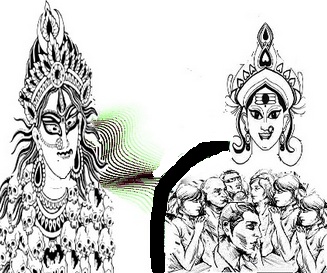
198. This is how in one manner or the other even the prime divines too get curses unknowingly. Thus, the regular and continuous worship of Kula Devatha or Tutelary/Family deity give protective cover to those families under the guard of Kula Devatha or Tutelary/Family deity.
199. There is however a small rider in this norm too. Since the divines are also meant for establishing law of justice and love amongst mankind, if the Kula Devatha or Tutelary/Family deity finds that the group ‘B’ had been wanton sinners against group ‘A’, then the Kula Devatha or Tutelary/Family deity of group ‘B’ would temporarily withdraw their protective cover from group ‘B’ to ensure that the canon of divine justice by way of boons given by divines to group ‘A’ are not blocked in any manner.
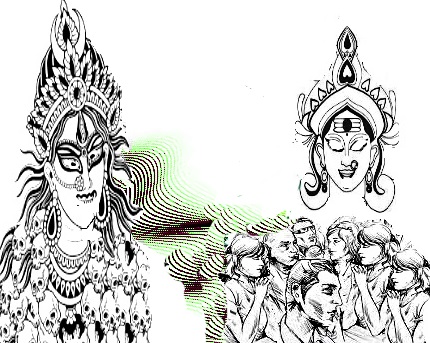
200. How does the punishment of divines leave effect and defaulters punished? Let us continue with the same group. Once the prayers of group ‘A’ is answered, then the resultant boon gets converted into the shape of negative energy rays and reach the person or group concerned say group ‘B,’ (who were engaged in the act of wrongful acts) and intrude into them activating harmful effects mentally thereby taking away their happiness and health. To allow the punishments to take place, the Kuladevatha of group ‘B’ will remain inactive. This results in endless struggle and mental agony to the ‘B’ group destabilizing them in many ways.
……….201 continued
References to all these points in last part

